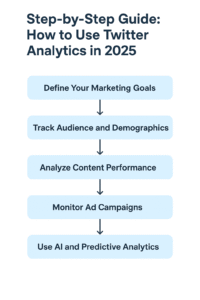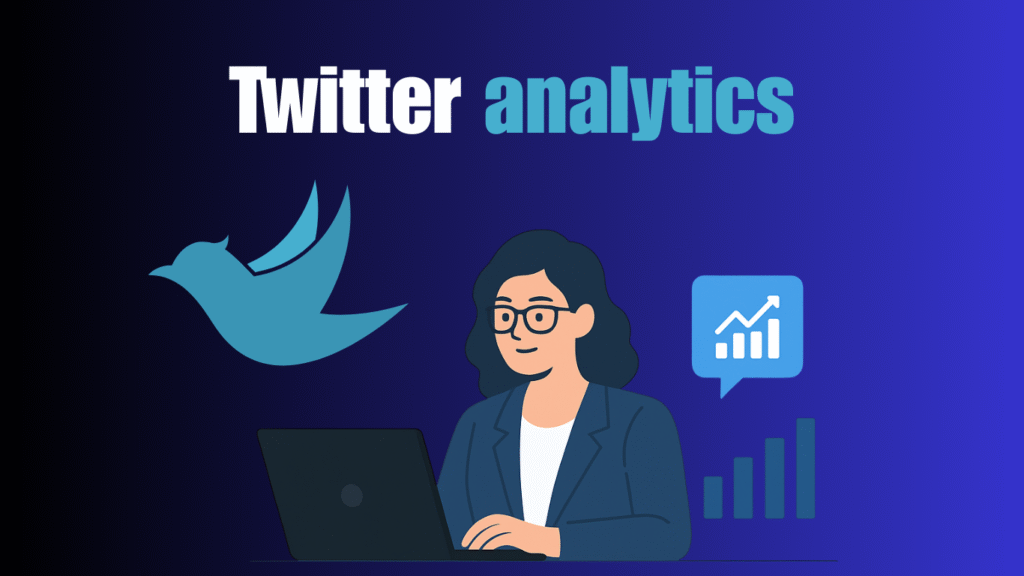In 2025, social media is no longer just a communication tool—it’s the backbone of digital marketing strategies. Among the many platforms, Twitter (now X) continues to hold a unique place for real-time engagement, trend discovery, and audience interaction. For marketers, the key to mastering this platform lies in Twitter analytics, which provides actionable insights to shape campaigns, refine targeting, and measure ROI.
This guide explains everything you need to know about Twitter analytics in 2025, from understanding its importance to step-by-step strategies, tools, and advanced tactics.
What is Twitter Analytics?
Twitter analytics refers to the data, metrics, and insights that track your account performance, tweet engagement, and audience behavior. In 2025, analytics goes beyond simple likes and retweets—it incorporates AI-driven predictions, audience sentiment, and competitor benchmarking.
By using Twitter analytics, marketers can:
- Identify which content formats resonate most with audiences.
- Track conversions from tweets, ads, and organic engagement.
- Optimize campaigns for reach, engagement, and sales.
- Measure ROI across multiple digital channels.
In short, Twitter analytics transforms guesswork into data-driven decision-making.
Why Twitter Analytics Matters in 2025
The landscape of Twitter marketing is constantly evolving. Here’s why analytics is crucial today:
-
Real-Time Decision Making: AI dashboards allow brands to adjust campaigns instantly.
- Audience Insights: Analytics shows demographics, interests, and active times.
- Ad Performance Tracking: Marketers can compare organic vs. paid campaigns.
- Competitive Edge: Benchmarking against rivals highlights gaps and opportunities.
- Predictive Trends: 2025 tools forecast content performance before posting.
Key Metrics to Track in Twitter Analytics
Before learning the step-by-step process, it’s important to understand which metrics matter most. In 2025, Twitter analytics has evolved to include both traditional and AI-driven insights. By knowing which numbers to track, marketers can align their strategies with business goals more effectively.
Important metrics to monitor:
- Impressions – Number of times your tweets are viewed.
- Engagement Rate – Percentage of interactions compared to impressions.
- Click-Through Rate (CTR) – How often users click on your links.
- Follower Growth – Net gain or loss in audience size.
- Hashtag Performance – Which hashtags bring the most engagement.
- Sentiment Analysis – AI-based insight into audience emotions toward tweets.
- Conversion Tracking – How many sales or sign-ups come directly from Twitter.
This foundation ensures marketers know exactly what to measure when applying analytics insights in their campaigns.
Step-by-Step Guide: How to Use Twitter Analytics in 2025

To maximize success, follow this structured process for applying Twitter analytics effectively in 2025.
Define Your Marketing Goals
The first step in using Twitter analytics is to establish clear marketing goals. Without defined objectives, data can feel overwhelming and directionless. Goals help you filter the insights that matter and align them with business priorities.
- If your aim is brand awareness, focus on impressions, reach, and follower growth.
- If you want to drive sales conversions, prioritize CTR (Click-Through Rate), link clicks, and purchases.
- If your target is engagement, monitor retweets, replies, likes, and shares closely.
By linking every metric to a specific business outcome, you ensure your analytics efforts are not just numbers but actionable insights.
Track Audience and Demographics
Understanding who engages with your tweets is essential to tailoring campaigns. In 2025, Twitter analytics provides AI-enhanced demographic breakdowns, giving marketers a deeper understanding of their audience.
- Identify audience demographics such as age, gender, and location.
- Highlight top interests, trending hashtags, and follower behaviors.
- Predict peak activity times, ensuring your tweets gain maximum visibility.
With this knowledge, marketers can design campaigns that resonate with the right audience at the right time, leading to stronger engagement and loyalty.
Analyze Content Performance
Not all content drives the same results. By leveraging Twitter analytics, you can evaluate which content formats work best and adjust accordingly.
- Discover which tweet formats—like videos, polls, images, or threads—generate the most engagement.
- Compare engagement rates by content type to refine your posting strategy.
- Examine the connection between posting times and performance to optimize scheduling.
This step allows you to focus more resources on content that delivers value while phasing out underperforming tactics.
Monitor Ad Campaigns
For businesses investing in paid ads, Twitter analytics plays a critical role in campaign optimization. It helps track financial performance and audience response, ensuring maximum return on investment.
- Measure CTR (Click-Through Rate) for each ad creative to identify winning formats.
- Track Cost-per-Engagement (CPE) and overall ROI to control spending.
- Use conversion tracking to see how ads drive website traffic, sign-ups, or purchases.
Monitoring ads through analytics helps marketers continuously refine ad strategy, eliminate waste, and improve targeting accuracy.
Use AI and Predictive Analytics
In 2025, AI has transformed how marketers use Twitter analytics. Instead of only reviewing past data, predictive insights now guide future campaigns with precision.
- Forecast engagement levels before publishing content, helping optimize timing and tone.
- Receive real-time recommendations for hashtags, keywords, and trending topics.
- Compare expected results with historical campaign performance to make smarter decisions.
By adopting AI-driven tools, businesses can stay ahead of trends and build data-backed strategies that outsmart competitors.
Sample Twitter Analytics Dashboard (2025)
Here’s an example of what a modern Twitter analytics dashboard might include:
| Metric | Purpose | Why It Matters in 2025 |
|---|---|---|
| Impressions | Total views of tweets | Shows reach and visibility |
| Engagement Rate | Interactions vs. impressions | Measures relevance and interest |
| CTR (Click-Through Rate) | Percentage of link clicks | Tracks traffic and conversions |
| Follower Growth | Net increase/decrease in followers | Reflects brand authority |
| Sentiment Analysis | Audience mood toward tweets | Helps adjust tone and messaging |
Best Tools for Twitter Analytics in 2025
To fully leverage the potential of Twitter analytics in 2025, marketers should combine Twitter’s native dashboard with advanced third-party platforms. These tools not only provide raw data but also offer actionable insights, automation, and predictive intelligence. Choosing the right mix ensures that businesses get both high-level overviews and detailed breakdowns tailored to their goals.
- Twitter Analytics Dashboard – The free, official tool is now enhanced with AI features, offering real-time engagement tracking, audience demographics, and predictive performance insights. It’s perfect for businesses that want accessible and reliable data without extra costs.
- Hootsuite Analytics – A cross-platform solution that tracks Twitter alongside other channels, making it ideal for marketers managing multiple accounts. It helps measure unified ROI across different platforms.
- Sprout Social – Provides in-depth reporting, competitor benchmarking, and sentiment analysis. This tool is particularly powerful for brands that want to monitor both their own growth and their competitors’ strategies.
- Brandwatch – Specializes in sentiment tracking and trend analysis, helping marketers understand how audiences feel about tweets in real-time. It’s especially useful for managing brand reputation.
- Buffer Analyze – A lightweight, user-friendly tool for smaller businesses or teams. It simplifies reporting and helps identify which tweets drive the most engagement without overwhelming dashboards.
By combining these platforms, marketers can extract deeper insights, track performance across campaigns, and adapt strategies quickly in a fast-changing digital environment.
Advanced Tips to Improve Marketing with Twitter Analytics
Mastering Twitter analytics goes beyond simply checking metrics—it’s about applying insights to improve every stage of your marketing strategy. With AI advancements in 2025, marketers have more opportunities to turn data into actionable campaigns.
- Leverage Predictive Insights – Use AI-driven forecasts to post tweets when your audience is most active, boosting visibility and engagement rates.
- Experiment with A/B Testing – Compare variations of tweets, hashtags, visuals, or ad creatives to discover what resonates most with your audience.
- Integrate Analytics with CRM Tools – Connecting Twitter data with customer relationship management systems allows you to measure how tweets impact actual sales and conversions.
- Use Competitor Analysis – Benchmark your content strategies against competitors, identifying gaps and opportunities to outperform them.
- Automate Reporting – Streamline your workflow with automated dashboards and scheduled reports, allowing quicker decision-making and reduced manual effort.
- By applying these advanced strategies, businesses not only measure success but also actively enhance performance, making Twitter analytics a growth driver rather than just a reporting tool.
Conclusion
In 2025, Twitter analytics is more than just numbers—it’s a strategic tool that empowers marketers to predict, optimize, and scale campaigns with precision. Whether you’re aiming for reach, engagement, or conversions, the key is using data to make smarter decisions.
By defining goals, analyzing performance, leveraging AI, and adopting advanced tools, marketers can unlock the full potential of Twitter and stay ahead in the competitive digital landscape.
Frequently Asked Questions (FAQs)
What is Twitter analytics used for in 2025?
Twitter analytics in 2025 helps marketers track performance, measure engagement, and understand audience behavior. It provides insights into impressions, clicks, and conversions. With AI-driven features, it also predicts campaign outcomes. This makes it a powerful tool for optimizing digital strategies.
How do I access Twitter analytics?
You can access Twitter analytics directly from your Twitter dashboard under the “Analytics” tab. Businesses using advanced tools may also connect third-party platforms for deeper insights. In 2025, AI-powered dashboards are common. These allow for real-time monitoring and predictive reporting.
Which metrics are most important in Twitter analytics?
The key metrics in Twitter analytics depend on your marketing goals. For awareness, impressions and reach matter most. For engagement, focus on retweets, replies, and shares. For sales, track CTR and conversions. In 2025, sentiment analysis has also become essential.
Can Twitter analytics improve ad performance?
Yes, Twitter analytics is critical for monitoring paid campaigns. It helps measure cost-per-engagement (CPE), click-through rates, and conversions. In 2025, AI-based recommendations also guide ad optimization. This ensures that marketers spend budgets effectively and achieve higher ROI.
How often should I review Twitter analytics?
It’s best to review Twitter analytics weekly to spot trends and monthly for deeper strategy updates. In 2025, predictive tools allow real-time adjustments. This means marketers no longer wait for reports but optimize campaigns instantly. Regular tracking ensures long-term growth.
